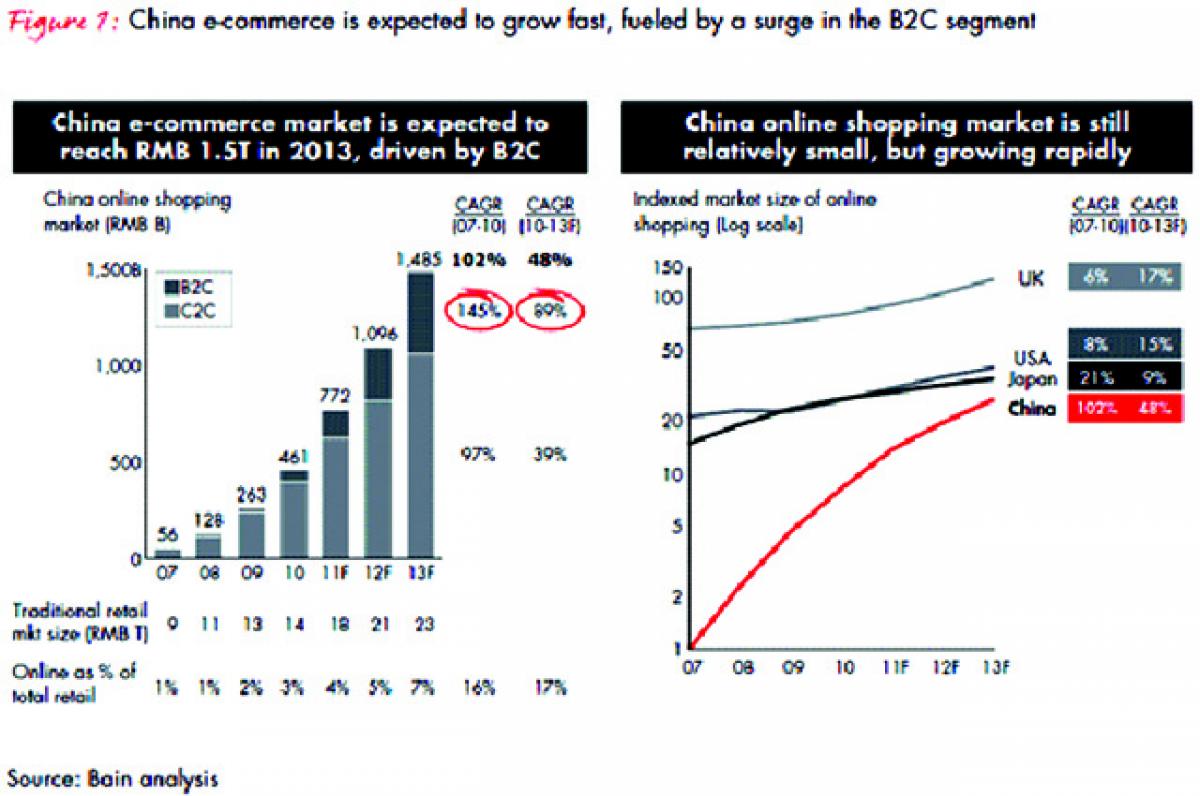Live
- From overcoming setbacks to leading India in U19 Women’s Asia Cup, Niki Prasad's amazing journey
- Constitution debate: PM Modi hails 'Nari Shakti'; makes strong pitch for 'United Bharat’
- Bihar: Inquiry initiated against principal who went to buy veggies during school hours
- TN: DMK postpones executive meet due to heavy rains & Parliament session
- Porous silicon oxide electrodes can fix durability issues in batteries: Researchers
- Jalandhar civic polls: AAP promises launch of 100 e-buses, round the clock water supply
- Economic upliftment of rural women is priority of Tripura govt: CM Saha
- Rajmata Jijabai Trophy: Manipur move to top of the table, T.N register first win
- Italian envoy Baroli hoping to strengthen ties with India through football
- CPI-M revokes suspension of Bengal party leader accused of sexual harassment
Just In

E-Commerce market-India way behind China. Retail e-commerce sales in India are expected to reach $17.5 billion (Rs.105,120 crore) by 2018, from $5.3 billion (Rs 31,800 crore) in 2014, according to data analysed by e-Marketer, a digital-research firm, but only two of 10 internet users in India shop online.
Retail e-commerce sales in India are expected to reach $17.5 billion (Rs.105,120 crore) by 2018, from $5.3 billion (Rs 31,800 crore) in 2014, according to data analysed by e-Marketer, a digital-research firm, but only two of 10 internet users in India shop online.

India’s e-commerce market is intensely competitive, with US giant Amazon establishing its presence in India in 2013 and Alibaba, the Chinese giant, planning to start selling by August this year. Flipkart, India’s largest e-commerce firm, recently raised $550 million (Rs.3,300 crore) at a valuation of $15 billion (Rs.90,000 crore).
Despite having the third-largest internet user base in the world with 200 million users at the end of 2014, India does not feature in the top 10 e-commerce markets in the world, according to an eMarketer report. The reasons centre on low Internet reach, slow internet speeds outside the metropolitan cities and poor customer services.
India’s e-commerce sales in 2014 were $5.3 billion (Rs.31,800 crore) -- 80 times smaller than China’s $426.26 billion (Rs.2,557,760 crore) and 58 times smaller than US’ $305.6 billion (Rs.1,833,900 crore).
“If you look at Japan, China and US, e-commerce became popular as early as 2002-2003. It has taken them about 12-13 years to reach where they have reached. E-commerce really took off in India only in 2012-13. It will take India also that much time to reach there,” Rajnish (he uses only one name), a technology expert, said.
China and the US accounted for more than 55 percent of global internet retail sales in 2014. China’s growth over the next five years will widen the gap between the two countries. China will likely exceed $1 trillion (Rs.6,000,000 crore) in retail ecommerce sales by 2018, accounting for more than 40% of the total worldwide.
Globally, retail sales reached $22.492 trillion (Rs.134,952,000 crore) in 2014 but retail e-commerce sales stood at $1.316 trillion (Rs.7,896,000 crore, 5.9 percent of overall retail sales). E-commerce sales are expected to increase 89 percent to $2.489 trillion (Rs.14,934,000 crore, 8.8 percent of overall retail sales) in 2018.
Digital-buyer penetration -- a measure of digital reach -- is a major factor in determining the success of retail e-commerce sales. India’s digital-buyer penetration was quite low at 24.4 percent in 2014 as compared to the global average of 41.6 percent.
The UK leads the world with 88% penetration. Ironically, China with 55.2 percent and US with 74.4 perent penetration do not feature in the top five. Indian e-commerce has a long way to go. “E-commerce in India still has a lot of friction,” Rajnish said. “Till that is solved, it will be hard for penetration to go beyond 30 percent. For example, India has very low credit-card penetration and the cash-on-delivery (COD) model is why Flipkart really took off.”
People above 35 are not very comfortable using their debit card online. PayTm and others solve this problem but there is a lot of friction. “I use PayTm for Uber and it is still a process that has friction. ?In US, the return policy is very generous. I bought a coat from Amazon in the Bay area; it ended up being the wrong size.
My experience of changing to the correct size was very seamless. When I bought a down jacket in Bangalore, and it ended up being the wrong size, getting the right size was really a painful experience,” said Rajnish. That view is echoed by Paritosh Sharma, an advisor to tech startups and an entrepreneur with PayUMoney, a digital-payment platform.
“Digital buying has an attached expectation to it. I place the order and it should appear in front of me over the next two or three days. In many cases this does not happen. Also, in a lot of cases (especially in Tier-2 and Tier-3 cities) in India, if you get a product that is not of the exact quality that you ordered, returning it is a major problem. Most people, hence, prefer what’s available in a physical retail store,” Sharma said.
There are two more reasons for low online sales, said Sharma. First, the internet infrastructure in India is poor. If one steps outside city limits, you automatically are shifted from 3G to an Edge (a lower-speed) connection, deterring buyers.
Second, lack of good service and support. While most Indian e-commerce companies are sprucing up their support via phone and digital media, it’s quite haphazard. Most companies still lack processes to ensure customer satisfaction and trust.
By Devanik Saha

© 2024 Hyderabad Media House Limited/The Hans India. All rights reserved. Powered by hocalwire.com







